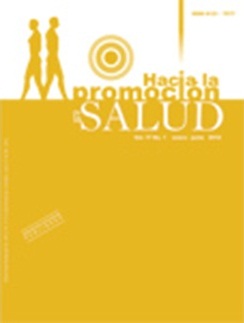Authors
Abstract
Adolescence is a stage in which a series of physical, psychological and social factors arise which contribute to the personality shaping;, the way in which adolescents face these changes are reflected in the permissibility and violence behaviors they externalize to various situations of everyday life. Objective: to validate the nursing diagnosis “risk of violence directed to others” among adolescents attending school. Method: a cross-sectional study, where the population was teenagers from a Middle School in Rionegro (Santander, Colombia). The main variable was the “risk of violence directed at others”, the data collection was carried out using an assessment screening instrument for the adolescent attending school. The clinical validity of the diagnosis, was performed using factor analysis and Rasch analysis. Results: the population comprised 300 adolescents, the median age was 14 years, and 58.67% were female. The items that fitted the Rasch model analysis with a INFIT are ranging between 0.85 the lowest and 1.24 the the highest, and OUTFIT ranging between 0.65 the lowest and 1.77 the highest. It shows that women are more assailant than males, with a mean of 1.53 risk of violence for women and an average of 1.03 for men, with a probability p=0.0006. Conclusion: clinical validation of nursing diagnoses, contributes to the evidence and the growth of the profession as a science of care.
References
De Miguel M, Ortiz L, Reyes N, Pedraz MI, Martín B, Olivares J. Detección de víctimas de bullying en un centro de Atención Primaria. Semergen 2008;8:375-378.
Cepeda E, Pacheco P, García L, Piraquive C. Acoso escolar a estudiantes de educación básica y media. Rev Salud Pública 2008;10(4):517-528.
Picchia R. A prática de violência entre pares: o bullying nas escolas. Revista Iberoamericana de Educación 2005;37:93-102.
Olweus D. Stability of aggressive reaction patterns in males: A review. Psychological Bulletin 1976;86:852-75.
República de Colombia. Ministerio de Protección Social. Informe especial sobre la violencia contra la infancia en Colombia. 2006. Disponible en: http://catedradh.unesco.unam.mx/BibliotecaV2/Documentos/Trata/Informes/informe_infancia.pdf
Rodríguez R, Seoane A, Pedreira JL. Niños contra niños: el bullying como trastorno emergente. An Pediatr 2006;64(2):162-6.
Oliveira AS, Da Silva P. Sentimientos del adolescente frente al fenómeno bullying: posibilidades para la asistencia de Enfermería en ese contexto. Revista Eletrônica de Enfermagem 2006;8(1):30-41.
Rioseco Virginia. El silencio que hace ruido. 2006. p. 2. Disponible en: http://miradaglobal.com/index.php?option=com_content&view=article&id=672%3Ael-silencio-que-hace-ruido&catid=30%3Asociedad&Itemid=34&lang =es
Lecannelier F. Bullying, Violencia Escolar: ¿Qué es y cómo intervenir? Unidad de Intervención Temprana. Facultad de Psicología, Universidad del Desarrollo. 2007. p. 3. Disponible en: http://www.acosomoral.org/pdf/BullyingFelipeLecannelier%5B1%5D.pdf
Frisen A, Johnson A, Person C. Adolescents’ perception of bullying: Who is the victim? Who is the bully? What can be done to stop bullying? Adolescence 2007;42(168):749-761.
Alfaro R. Aplicación del proceso enfermero. Guía paso a paso. 4th ed. Barcelona: Springer-Verlag Ibérica; 1999. p. 4-9.
Fehring R. Methods to validate nursing diagnoses. Heart & Lung 1987; 16(5):625-629.
NANDA. Diagnósticos Enfermeros: Definiciones y Clasificaciones 2009-2011. Barcelona: Elsevier; 2010. p.328.
Carpenito-Moyet LJ. Handbook of Nursing Diagnosis. 11th ed. Lippincott Williams & Wilkins; 2006. p. 527-31.
Griffith G. Process and Methodologies for Research Validation of Nursing Diagnosis. Nursing Diagnosis 1999 January-March;10:5-14.
Hoyos O, Aparicio J, Heilbron K, Schamun V., et al. Representaciones sobre el maltrato entre iguales en niñas y niños escolarizados de 9, 11 y 13 años de nivel socioeconómico alto y bajo de la ciudad de Barranquilla. Psicología desde el Caribe 2004;14:150-172.
Orozco L, Valdivieso M, Forero C, Ardila M, Molina H, Niño C., et al. Prevalencia de los diagnósticos de enfermería en adolescentes escolarizados de la ciudad de Bucaramanga en el año 2006-2007. En prensa 2009.
Pinilla E, Orozco L, Estupiñán M, Martínez M, Zabala L. Eficacia de las intervenciones de Enfermería: Terapia Artística, Terapia con Juegos, Distracción, para el diagnóstico de enfermería Riesgo de violencia dirigida a otros en niños víctimas de la violencia. En prensa 2009.
CDC. Epi Info, versión 6.04d. Epidemiología en ordenadores. Atlanta, Georgia. Enero, 2001.
StataCorp. Stata Statistical Software: Release 10. College Station, TX: Stata Corporation. 2008.
Winsteps & Facets: Rasch software. 2009.
Colombia. Ministerio de Salud. Resolución Número 8430. Normas Científicas, Técnicas y Administrativas para la Investigación en Salud. 1993. Disponible en: http://www.minproteccionsocial.gov.co/Normatividad/RESOLUCION%208430%20DE%201993.pdf
Orte S. Bullying: la necesidad del abordaje multidisciplinario. Universitat de les Illes Balears 2005;12(3):130-8.
Olweus, D. Bullying at school: What We Know and What We Can Do. Malden, Massachusetts: Blackwell Publishing; 1993.
Olweus, D. Acoso escolar, “bullying”, en las escuelas: hechos e intervenciones. Centro de Investigación para la Promoción de la Salud, Universidad de Bergen, Noruega; 1993.
Parra L, Ortiz N, Barriga O, Henríquez G, Neira M, et al. Efecto de un taller vivencial de orientación humanista en la auto-actualización de adolescentes de nivel socioeconómico bajo. Ciencia y Enfermería 2006;12(1):61-72. [citado 2009 Feb]. Disponible en: http://www.scielo.cl/scielo.php?pid=S0717-95532006000100007&script=sci_arttext


 PDF (Español)
PDF (Español)
 FLIP
FLIP






















